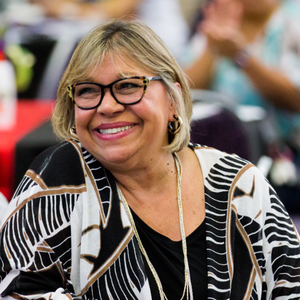
In northeast Denver, only 9 percent of public school teachers are Hispanic, and about 2 percent are Hispanic men—despite the fact that the Hispanic student population is the fastest growing in the country, making up about a quarter of K-12 students.
Angel Magana is now studying elementary education at the University of Colorado Denver and is enrolled in the school’s NxtGEN Teacher Residency program, which allows him to work as a paid paraprofessional at a local elementary school while working toward his teaching degree.
Magana’s trajectory into teaching formally started when he was a senior in high school. He enrolled in Pathways2Teaching, a class designed for students of color to earn college credit by studying issues related to educational justice.
The goal of the class, said Margarita Bianco, the founder and executive director of Pathways2Teaching, is for students of color to understand the inequities of their school system, and then come back to be “agents of change”—as teachers.
“You can’t be who you can’t see,” Bianco said. “For Latino young men, they often think of teaching as a female-dominated profession, and it is if they only see white females in front of the classroom. It’s race and it’s gender.”
Many students of color, she said, have never been encouraged to become teachers. Indeed, Magana said his family initially pushed back against the idea of him teaching.
“In a masculine Latino family, it’s looked at as a feminine profession,” Magana said. “It was kind of a shock to the system. It’s sort of a tradition [in our family that] you’re outside, you’re painting, you’re doing construction, heavy work like that.”
He also credits Bianco, from Pathways2Teaching, for giving him extra support and guidance.
“It really does take a village, not just me, but my whole team,” said Bianco, who is also an associate professor of special education at the University of Colorado Denver. “We become an extended family, just making sure they’re on the right track at every juncture.”
“I think nationally, we’re really poised to tackle this issue,” said David Fuentes, an associate professor of elementary education at William Paterson University, a Hispanic-serving institution in New Jersey.
The college-enrollment rate has risen at a faster rate for Hispanic high school graduates than it has for white, black, and Asian high school graduates—in 2016, nearly half of Hispanic high school graduates were enrolled in college, up from 32 percent in 1999.
“Our country is changing,” Fuentes said. “Part of that tells me there will be inevitable changes to education. … But somehow, education completely subverts societal trends.”
Indeed, a 2016 study by the Brown Center on Education Policy at the Brookings Institution and the National Council on Teacher Quality found that the teacher diversity gap is stubborn: The proportional difference between Hispanic teachers and Hispanic students is expected to actually increase by 4 percentage points, to about 22 percent in 2060. This is because the number of Hispanic teachers is not increasing at a rate commensurate with the rapid growth of Hispanic students.
For his part, Magana hopes to be a model for other Latino men who aspire to be teachers. But for now, he’s excited about his own future. He’s considering becoming a principal, an administrator, even a district superintendent.
“The sky is the limit, really,” he said. But first, he said, “I want to be a teacher for a long time.”
Read the full story by Madeline Will in EDUCATION WEEK: January 24, 2018, as Latino Male Teachers: Building the Pipeline
The U.S. Army Corps of Engineers has been tasked with…
Brown and Caldwell, a leading environmental engineering and construction firm,…
Humboldt State University, one of four campuses within the California…